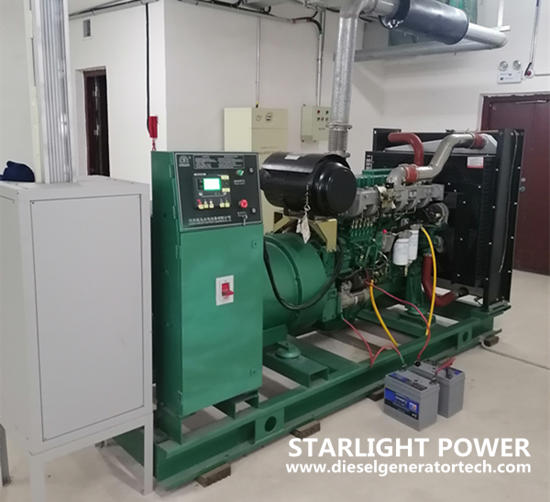What is relationship between insulation grade and temperature rise of generator? Today Starlight Power answers for you.
Insulation grade of generator
Insulation grade refers to the heat resistance grade of insulation material used in generator winding. The insulation materials commonly used in generator and transformer are A, E, B, F and H. The insulation material of each insulation grade has corresponding limit allowable working temperature (the temperature of the hottest spot of generator winding). Generator of diesel genset usually is H grade.
Temperature of insulation grade
A grade:
Allowable max. temperature 105℃, winding temperature rise limit 60K, performance reference temperature 80℃.
E grade:
Allowable max. temperature 120℃, winding temperature rise limit 75K, performance reference temperature 95℃.
B grade:
allowable max. temperature 130℃, winding temperature rise limit 80K, performance reference temperature 100℃.
F grade:
Allowable max. temperature 155℃, winding temperature rise limit 100K, performance reference temperature 120℃.
H grade: allowable max. temperature 180℃, winding temperature rise limit 125K, performance reference temperature 145℃.

Temperature rise of generator
Temperature rise is the temperature difference between the generator and the environment, which is caused by the generator heating. Temperature rise refers to the temperature of each component in generator higher than the environment. When the generator core is in the alternating magnetic field, there will be iron loss, copper loss and other stray losses after the winding is electrified, which causes temperature of generator increased. Another side, generator can also dissipate heat. When the heating and heat dissipation are equal, the equilibrium state is reached, and the temperature is no longer rising but stable at a level. When heating increased and heat dissipation decreased, will cause temperature rise and expand temperature difference, then increase heat dissipation. A new equilibrium is reached at another higher temperature. But at this time, the temperature difference has been bigger than before. Therefore, temperature difference is an important point when design and operation of generator, which indicates the heating situation of generator. If generator temperature difference is increase suddenly, it indicates the generator has fault. Or the air duct is blocked or the load is too heavy.
Generator temperature refers to the actual heating temperature of each part of the generator, which has a great impact on the insulation material of the generator. If the temperature is too high, the insulation aging will be shortened, and even the insulation will be damaged. In order to prevent the aging and damage of the insulation, the temperature limit is the allowable temperature of the generator.
In generator and other electrical equipment, insulation material is the weakest link. Insulation materials are especially vulnerable to high temperature and accelerated aging and damage. Different insulation materials have different heat resistance, and electrical equipment with different insulation materials has different ability to withstand high temperature. Therefore, the general electrical equipment is required to work at the highest temperature.
With the occurrence of generator failure, the phenomenon of generator overheating will appear generally, which is very unfavorable to the insulation of generator. The most sensitive part of the generator to heat reaction is the stator winding insulation. Each insulation material can only bear a certain temperature. If the temperature exceeds the allowable temperature, it will accelerate the aging of the insulation, shorten the service life of the generator, and may cause various accidents due to insulation damage. Therefore, the inspection, detection and protection of generator overheat fault is very important for reducing accident rate, reducing accident loss and improving economic benefits of enterprises.
How to test the insulation grade of diesel generator?
1.Electrometric method
The electric measurement method is divided into pulse current method and radio interference method. The pulse current method is used to detect the parameters of partial discharge (PD) during the operation of generator set, that is, the partial discharge is the pulse current generated. Radio interference voltage method is used to detect the electromagnetic radiation wave generated by partial discharge of generator. Because the pulse current method can calibrate the discharge core according to the equivalent circuit of partial discharge, and has high detection sensitivity, it is a commonly used method at present.
2.Non electric measurement method
Non electric measurement method is a method to detect the partial discharge of generator set by acoustic and special gas instead of measuring electric parameters. There are two kinds of non electrical detection methods commonly used: one is ultrasonic detection. When the generator is partially discharged, it will generate pulse, whose frequency spectrum is about 1hm, but its acoustic signal is very Microsoft. Ultrasonic detection will be its signal into electrical signals after amplification output, the other is ozone, concentration detection method, because ozone is the characteristic gas of generator point halo. An ozone detection device is set up in the generator set. By detecting the ozone concentration to judge the voltage state of the generator set, the partial discharge state strength of the generator in operation can be determined, so as to effectively monitor the insulation of the generator.
If you have purchase plan for diesel generator set, welcome to send us inquiry by our email [email protected], we will work with you.
Copyright © Guangxi Dingbo Generator Set Manufacturing Co., Ltd. All Rights Reserved | Sitemap
Update cookies preferences